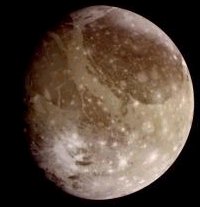|
Ganymede
The
@stro object for the week of 02/28/2000

image
courtesy of SEDS
Ganymede.
Ganymede
is one of the "Galilean Moons" orbiting Jupiter. This
rocky & icy moon was first discovered in 1610 by Galileo. It
is the largest satellite in the solar system and is even larger
than the planet Pluto. Ganymede is thought to be composed of three
layers: (1) a molten core, (2) a rocky mantle and (3) an icy shell.
Meteor impact craters abound on the surface and the areas of white
coloration in the image are in fact patches of clean ice kicked
up by these impacts. In addition, Ganymede has its own magnetic
field, and there is evidence of past tectonic action, although no
current surface shifting has been discovered.
Ganymede is
easily visible in a small telescope if it is not behind Jupiter
from our perspective. The Galileo
spacecraft in orbit around Jupiter has made many fantastic fly-bys
of Ganymede and taken many excellent images of its surface.
| Current
information for Ganymede (info for Jupiter - North America): |
| Rise: 0839
PST |
| Set: 2250
PST |
| Constellation:
Aries |
more
info...
|